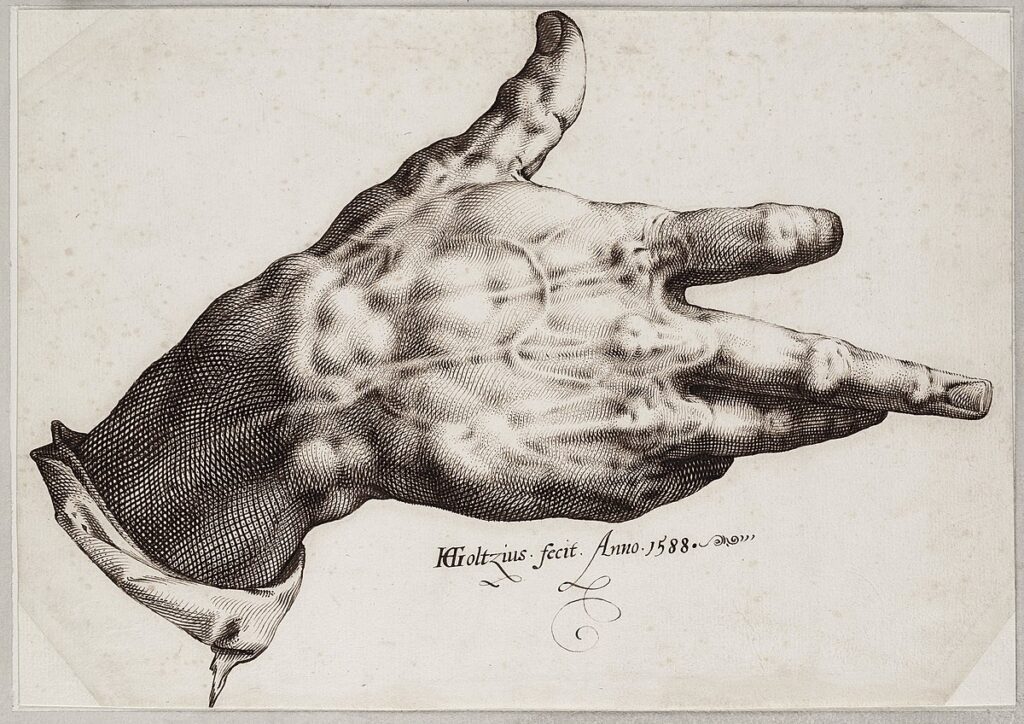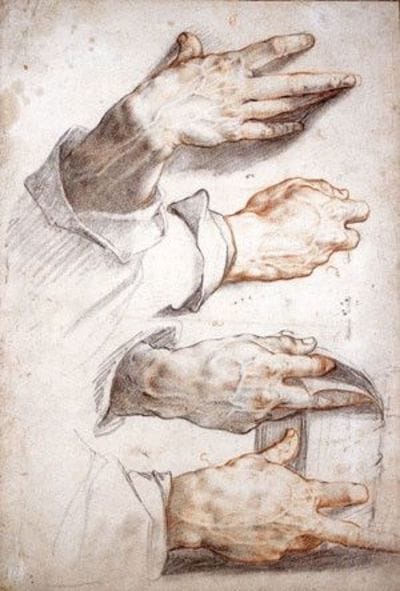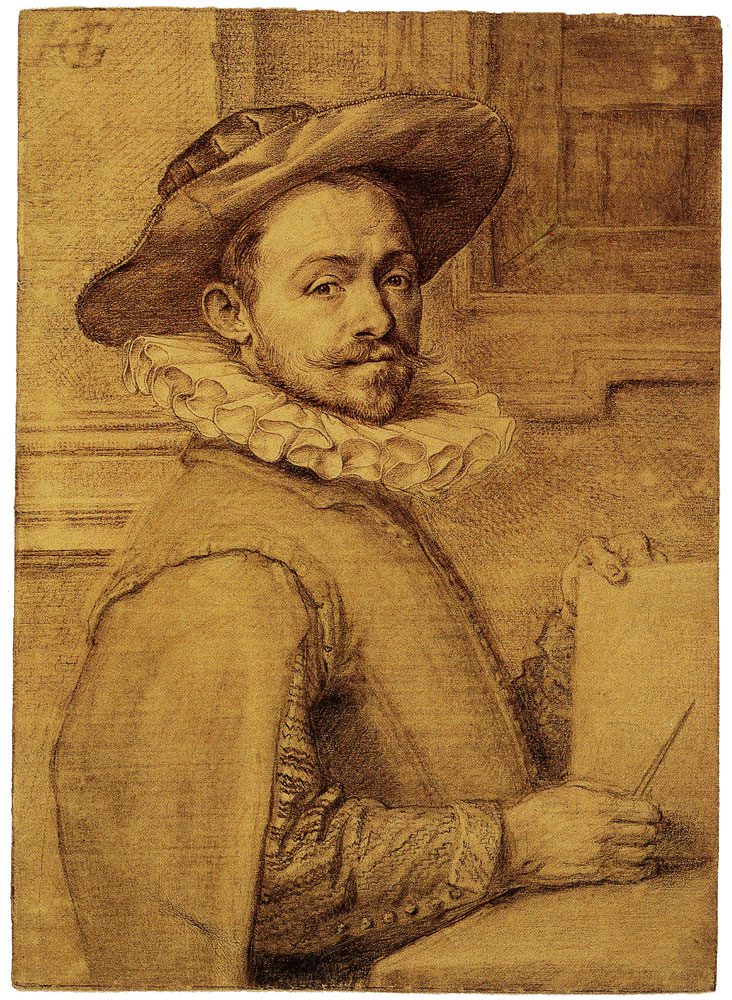James L. Franklin
Chicago, Illinois, United States

In 1588, when Hendrick Goltzius created this striking drawing (Fig. 1) of his deformed right hand, the thirty-year old Haarlem draftsman and engraver was already one of the most influential, well-recognized artists in Europe. In a sense, the drawing was his signature writ large, as evidenced in an anecdote from Karl van Mander’s biography of the artist. In April 1591, while Goltzius was on his “grand tour” of Italy, he traveled incognito as a Dutch cheese merchant. Shabbily dressed to discourage robbers, he traveled from Rome to Naples with Haarlem silversmith Jan Matthijsz Ban and a young antiquary, Philips van Winghe. The later, unaware of the identity of his famous traveling companion, had learned that the artist was in Italy and greatly desired to meet him. When Matthijsz Ban told him the identity of their companion, he could not believe the famous artist would travel so poorly clad until Goltzius showed him his withered hand and a handkerchief bearing the famous “HG” monogram.1
Goltzius’s Four Studies of Hands (Fig. 2) executed in red and black chalk on colored paper probably served as study material for artists in his studio, as hands are extremely difficult to draw. The hands on this sheet appear undamaged and the fingers well-formed. One author has speculated that Goltzius used his left hand as a model and drew it with the aid of a mirror. Art history records a tradition of drawings of a master’s hand serving as a trademark, and such pen and ink drawings were expensive collectable objects. Michelangelo was said to have produced a drawing of his hand on the spot for a patron who doubted his identity.2

Of the three well known self-portraits by the artist, it is the earliest (Fig. 3) dating from 1586–1590 that is of interest to our discussion, for it includes his hand. The technique the artist used for this self-portrait, metal point on tablet, was what he used for studies and portraits throughout his career. The tablet (tafelet)—a leaf of paper or parchment prepared with chalk and glue—often served as a sketchbook to be taken on a journey or on a walk. The self-portrait is completely finished, including elegant clothing and an affluent background setting. Goltzius clasps a burin in his right hand and a gleaming copper plate in his left. He unmistakably portrays himself as an engraver, the occupation at which he had achieved great fame in his late twenties and early thirties. The finished quality of the drawing leads one to the conclusion that it was intended for a patron or admiring friend. The self-portrait provides one further image of the artist’s right hand, though he does not call attention to the deformity.3
Hendrick Goltzius was born in Mühlbracht, today Bracht just inside the German border, in February 1558. He was the first child of Jan II Goltz, a stained glass-painter, who would be his first teacher. The most reliable account of the injury that maimed the hands of the infant Goltzius is found in Karl van Mander’s Schiler-boeck, published in Dutch in 1604. Karl van Mander (1548–1606) worked closely with Goltzius in Haarlem, and their friendship extended over 20 years. The Schiler-boeck is comparable to Giorgio Vasari’s Lives of the Most Excellent Painters, Sculptors, and Architects. It describes the life and work of more than 250 artists, the biographical sketch of Goltzius being the longest. From van Mander’s account we learn that when Goltzius was about one year old, he “fell into a fire with his face over a pan full of boiling oil and burned both hands on the red-hot coals. His mother tried to cure them with splints and ointment among other things, but was unable to prevent the child from suffering severe pain day and night. An officious neighbor took the splints off and bound the right hand in a cloth.” This was the reason why Goltzius was never able to fully open his right hand. Dr. F. Groenevelt, a Netherlandish plastic surgeon specializing in the treatment of the burned hand, has reviewed the hand in Goltzius’s drawings and finds them entirely consistent with a burn injury: “The upward angle and bend of the index finger may be the result of a deep burn of the back of the finger and particularly the first phalange—the ‘collar-button’ phenomenon. He finds the deformity of the middle finger, the ring finger and little finger entirely consistent with scarring from deep burns.”
Based on the direction of the cross-hatching in his drawings, it is speculated that Goltzius was right-handed, and he may have benefited from the stiffness of his fingers giving him a strong grip when engraving with a burin while forcing him to draw with his arm and shoulders. Walter Melion suggests that he engraved with his right hand and drew with his left.4

Despite the limitations imposed by his injury, his innate gifts and determination propelled his artistic career. After only a few brief years of schooling and an apprenticeship with his father as a glassmaker and stained-glass painter, he was accepted in 1574 into the studio of the Dutch engraver Dirck Volckertszoon Coornhert (1522–1590) in Xanten. Coornhert was well-known humanist and political figure, and it was fortunate he was willing to take on a youngster with a withered hand who might never be an engraver. Coornhert seems to have recognized the boy’s intellectual abilities and Goltzius became part of the sophisticated circle around the master. In 1577 Goltzius and his family followed Coornhert to Holland, where they settled in Haarlem. In the mid-1580s Goltzius met the polymath Karel van Mander, who arrived in Haarlem a destitute refuge from Flanders. It was van Mander who introduced Goltzius to the drawings of Bartholomeus Spranger (1546–1611), court painter to the Holy Roman Emperor Rudolf II and a leading artist of Northern Mannerism based in Prague. Spranger’s mannerist style had a profound influence on Goltzius’s subsequent work. Goltzius, van Mander, and the Haarlem painter Cornelis Cornelisz (1562–1638) entered into a partnership, creating a “Haarlem Academy.”
In 1579, Goltzius married Margretha Jansdr, a 30-year-old widow, who brought from her first marriage a modest inheritance and her son Jacob Adriaensz Marham, whom Goltzius tutored and who would become one of his most productive assistants. Other pupils joined his workshop which became ever more productive during the late 1580s. According to van Mander, during this productive period Goltzius suffered both mentally and physically, including the vomiting of blood, for which the doctors could find no remedy. Fearing he might not have long to live, the artist left his business in the hands of his stepson and in 1590 he undertook a long-deferred trip to Italy to see the great Italian masterpieces.
Returning to Haarlem in 1591, his experience in Italy allowed him to move beyond his mannerist style. During the years 1591 to 1600, “he produced his most virtuoso prints and pen and ink drawings.”5 Described as a chameleon, it is remarkable that after 1600 Goltzius was able to abandon printmaking and devote his activity to oil painting. Karl van Mander, who viewed painting as the summit of achievement in the arts and more prestigious than engraving, is thought to have influenced his decision.[6] Hendrick Goltzius died in the evening of January 1, 1617, just short of his sixty-ninth birthday, and was buried in the Grote Kerk in Haarlem. A late drawing, Youth With Skull of 1614, reveals that the power of his eye and hand was undiminished with age.
References
- Huigen Leeflang, Hendrick Goltzius (1558–1617): Drawings, Prints and Paintings. Waanders Publishers, Rijksmuseum, Amsterdam, 2004. Chapter IX His Artful Pen, Hugen Leeflang, p. 244. (Leeflang’s Hendrick Goltzius (1558–1617) is an invaluable reference for information on the artist and a reference source for the material in this paper.)
- Leeflang, “Chapter IX: His Artful Pen,” p. 248.
- Leeflang, “Chapter I: The Life of Hendrick Goltzius (1558–1617),” p. 22.
- Melion, Walter S. Shaping the Netherlandish Canon: Karl Van Mander’s Schilder-Boeck, University of Chicago Press, 1991.
- Leeflang, “Chapter I: The Life of Hendrick Goltzius (1558—1617),” p. 19.
- Nadine Orenstein. “Hendrick Goltzius (1558–1617).” Heilbrunn Timeline of Art History: Essays, The Metropolitan Museum of Art, October 2003. https://www.metmuseum.org/toah/hd/golt/hd_golt.htm
JAMES L. FRANKLIN is a gastroenterologist and associate professor emeritus at Rush University Medical Center. He also serves on the editorial board of Hektoen International and as the president of Hektoen’s Society of Medical History & Humanities.

Leave a Reply